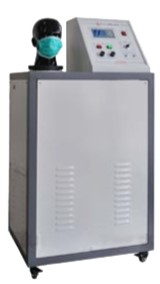
NewsInformation Center
Face Mask Fabric and Non-Woven Mask and Breathing Respiratory Resistance Tester
2023/09/07
To test the breathability and respiratory resistance of face mask fabrics, including non-woven masks, a Breathing Respiratory Resistance Tester (also known as a Differential Pressure Tester) can be used. This instrument measures the pressure drop across the mask material when air is passed through it at a specified flow rate.
1. Touch screen control, Chinese and English menu, man-machine dialogue mode, easy to operate.
2. Built-in thermal printer to facilitate quick printing of test results on site.
3. High precision differential pressure sensor and digital flowmeter, high test accuracy.
4. Two modes of breath detection and breath detection can be set.
5. Automatic pipeline switching device of respirator solves the problem of pipe extubation and wrong connection when testing.
6. 3D printed standard head mold, which can simulate the real inhalation and exhalation of the human body, and improve the accuracy of data.


The testing process typically involves the following steps:
1. Prepare the sample: Cut a properly-sized sample from the face mask or non-woven material for testing. Pay attention to the test area and any specific requirements based on standards or guidelines.
2. Set up the equipment: Install the sample securely over the test area of the instrument, ensuring a proper seal to avoid air leakage around the edges.
3. Conduct the test: Apply a constant flow of air through the sample at a specified rate. The instrument measures the pressure drop across the sample, which indicates the level of breathing resistance. Lower pressure drop values indicate better breathability.
4. Record and analyze the results: Note the pressure drop values obtained during the test. These values can be compared to established standards or guidelines to determine the breathability of the face mask fabric.
It's important to note that each testing method may have its own specific requirements, and results may vary depending on factors such as the design and construction of the mask, the number of layers, and the composition of the fabric. Using recognized testing protocols, following relevant standards, and consulting with accredited testing laboratories can provide accurate and reliable results.
Please keep in mind that the information and procedures provided here are general guidelines. It's recommended to refer to specific testing standards and consult with professionals in the field to ensure proper testing procedures are followed.
Previous: Surgical Masks Textile Martindale Abrasion Tester
N e x t : How do you test for burning cotton and linen?



